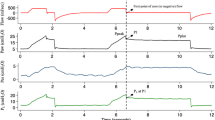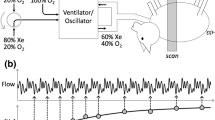Abstract
We have advanced a commercially available ventilator (NPB840, Puritan Bennett/Tyco Healthcare, Pleasanton, CA) to deliver an Enhanced Ventilation Waveform (EVW). This EVW delivers a broadband waveform that contains discrete frequencies blended to provide a tidal breath, followed by passive exhalation. The EVW allows breath-by-breath estimates of frequency dependence of lung and total respiratory resistance (R) and elastance (E) from 0.2 to 8 Hz. We hypothesized that the EVW approach could provide continuous ventilation simultaneously with an advanced evaluation of mechanical heterogeneities under heterogeneous airway and tissue disease conditions. We applied the EVW in five sheep before and after a bronchial challenge and an oleic acid (OA) acute lung injury model. In all sheep, the EVW maintained gas exchange during and after bronchoconstriction, as well as during OA injury. Data revealed a range of disease conditions from mild to severe with heterogeneities and airway closures. Correlations were found between the arterial partial pressure of oxygen (PaO2) and the levels and frequency-dependent features of R and E that are indicative of mechanical heterogeneity and tissue disease. Lumped parameter models provided additional insight on heterogeneous airway and tissue disease. In summary, information obtained from EVW analysis can provide enhanced guidance on the efficiency of ventilator settings and on patient status during mechanical ventilation.
Similar content being viewed by others
References
Avanzolini, G., P. Barbini, F. Bernardi, G. Cevenini, and G. Gnudi. Role of the mechanical properties of tracheobronchial airways in determining the respiratory resistance time course. Ann. Biomed. Eng. 29:575–586, 2001.
Baldi, S., M. Miniati, C. R. Bellina, L. Battolla, G. Catapano, E. Begliomini, D. Giustini, and C. Giuntini. Relationship between extent of pulmonary emphysema by high-resolution computed tomography and lung elastic recoil in patients with chronic obstructive pulmonary disease. Am. J. Respir. Crit. Care Med. 164:585–589, 2001.
Barnas, G. M., P. Harinath, M. D. Green, B. Suki, D. W. Kaczka, and K. R. Lutchen. Influence of waveform and analysis technique on lung and chest wall properties. Respir. Physiol. 96:331–344, 1994.
Brown, R. H., and E. M. Wagner. Mechanisms of bronchoprotection by anesthetic induction agents: Propofol versus ketamine. Anesthesiology. 90:822–828, 1999.
Coulson, N. M., A. J. Januszkiewicz, and G. R. Ripple. Physiological responses of sheep to two hours anaesthesia with diazepam-ketamine. Vet. Rec. 129:329–332, 1991.
Dreyfuss, D., and G. Saumon. Ventilator-induced lung injury: Lessons from experimental studies. Am. J. Respir. Crit. Care Med. 157:294–323, 1998.
Farre, R., M. Ferrer, M. Rotger, and D. Navajas. Servocontrolled generator to measure respiratory impedance from 0.25 to 26 Hz in ventilated patients at different PEEP levels. Eur. Respir. J. 8:1222–1227, 1995.
Gattinoni, L., L. D’Andrea, P. Pelosi, G. Vitale, A. Pesenti, and R. Fumagalli. Regional effects and mechanism of positive end-expiratory pressure in early adult respiratory distress syndrome. JAMA. 269:2122–2127, 1993.
Gillis, H. L., and K. R. Lutchen. Airway remodeling in asthma amplifies heterogeneities in smooth muscle shortening causing hyperresponsiveness. J. Appl. Physiol. 86:2001–2012, 1999.
Gillis, H. L., and K. R. Lutchen. How heterogeneous bronchoconstriction affects ventilation distribution in human lungs: A morphometric model. Ann. Biomed. Eng. 27:14–22, 1999.
Hantos, Z., B. Daroczy, B. Suki, S. Nagy, and J. J. Fredberg. Input impedance and peripheral inhomogeneity of dog lungs. J. Appl. Physiol. 72:168–178, 1992.
Henderson, A. C., E. P. Ingenito, H. Atileh, E. Israel, B. Suki, and K. R. Lutchen. How does airway inflammation modulate asthmatic airway constriction? An antigen challenge study. J. Appl. Physiol. 95:873–882; Discussion 863, 2003.
Hickling, K. G. Best compliance during a decremental, but not incremental, positive end-expiratory pressure trial is related to open-lung positive end-expiratory pressure: A mathematical model of acute respiratory distress syndrome lungs. Am. J. Respir. Crit. Care Med. 163:69–78, 2001.
Hubler, M., J. E. Souders, E. D. Shade, N. L. Polissar, C. Schimmel, and M. P. Hlastala. Effects of vaporized perfluorocarbon on pulmonary blood flow and ventilation/perfusion distribution in a model of acute respiratory distress syndrome. Anesthesiology. 95:1414–1421, 2001.
Ito, S., E. P. Ingenito, S. P. Arold, H. Parameswaran, N. T. Tgavalekos, K. R. Lutchen, and B. Suki. Tissue heterogeneity in the mouse lung: effects of elastase treatment. J. Appl. Physiol. 97:204–212, 2004.
Kaczka, D. W., G. M. Barnas, B. Suki, and K. R. Lutchen. Assessment of time-domain analyses for estimation of low-frequency respiratory mechanical properties and impedance spectra. Ann. Biomed. Eng. 23:135–151, 1995.
Kaczka, D. W., E. P. Ingenito, S. C. Body, S. E. Duffy, S. J. Mentzer, M. M. DeCamp, and K. R. Lutchen. Inspiratory lung impedance in COPD: Effects of PEEP and immediate impact of lung volume reduction surgery. J. Appl. Physiol. 90:1833–1841, 2001.
Kaczka, D. W., E. P. Ingenito, E. Israel, and K. R. Lutchen. Airway and lung tissue mechanics in asthma. Effects of albuterol. Am. J. Respir. Crit. Care Med. 159:169–178, 1999.
Kaczka, D. W., E. P. Ingenito, and K. R. Lutchen. Technique to determine inspiratory impedance during mechanical ventilation: Implications for flow limited patients. Ann. Biomed. Eng. 27:340–355, 1999.
Kaczka, D. W., E. P. Ingenito, B. Suki and K. R. Lutchen. Partitioning airway and lung tissue resistances in humans: Effects of bronchoconstriction. J. Appl. Physiol. 82:1531–1541, 1997.
Lauzon, A. M., and J. H. Bates. Estimation of time-varying respiratory mechanical parameters by recursive least squares. J. Appl. Physiol. 71:1159–1165, 1991.
Lutchen, K. R., and H. Gillis. Relationship between heterogeneous changes in airway morphometry and lung resistance and elastance. J. Appl. Physiol. 83:1192–1201, 1997.
Lutchen, K. R., Z. Hantos, F. Petak, A. Adamicza, and B. Suki. Airway inhomogeneities contribute to apparent lung tissue mechanics during constriction. J. Appl. Physiol. 80:1841–1849, 1996.
Lutchen, K. R., A. Jensen, H. Atileh, D. W. Kaczka, E. Israel, B. Suki, and E. P. Ingenito. Airway constriction pattern is a central component of asthma severity: The role of deep inspirations. Am. J. Respir. Crit. Care Med. 164:207–215, 2001.
Lutchen, K. R., D. W. Kaczka, B. Suki, G. Barnas, G. Cevenini, and P. Barbini. Low-frequency respiratory mechanics using ventilator-driven forced oscillations. J Appl. Physiol. 75:2549–2560, 1993.
Lutchen, K. R., B. Suki, Q. Zhang, F. Petak, B. Daroczy, and Z. Hantos. Airway and tissue mechanics during physiological breathing and bronchoconstriction in dogs. J. Appl. Physiol. 77:373–385, 1994.
Maggiore, S. M., J. C. Richard, and L. Brochard. What has been learnt from P/V curves in patients with acute lung injury/acute respiratory distress syndrome. Eur. Respir. J. Suppl. 42:22s–26s, 2003.
Muscedere, J. G., J. B. Mullen, K. Gan, and A. S. Slutsky. Tidal ventilation at low airway pressures can augment lung injury. Am. J. Respir. Crit. Care Med. 149:1327–1334, 1994.
Navajas, D., R. Farre, J. Canet, M. Rotger, and J. Sanchis. Respiratory input impedance in anesthetized paralyzed patients. J. Appl. Physiol. 69:1372–1379, 1990.
Norton, J. P. An Introduction to Identification. London; New York: Academic Press, 1985, 310.
Otis, A. B., C. B. McKerrow, R. A. Bartlett, J. Mead, M. B. McIlroy, N. J. Selverstone, and E. P. Radford. Mechanical factors in distribution of pulmonary ventilation. J. Appl. Physiol. 8:427–443, 1956.
Overbeck, M. C., T. Pranikoff, C. M. Yadao, and R. B. Hirschl. Efficacy of perfluorocarbon partial liquid ventilation in a large animal model of acute respiratory failure. Crit. Care Med. 24:1208–1214, 1996.
Petak, F., Z. Hantos, A. Adamicza, T. Asztalos, and P. D. Sly. Methacholine-induced bronchoconstriction in rats: Effects of intravenous vs. aerosol delivery. J. Appl. Physiol. 82:1479–1487, 1997.
Petak, F., Z. Hantos, A. Adamicza, and B. Daroczy. Partitioning of pulmonary impedance: Modeling vs. alveolar capsule approach. J. Appl. Physiol. 75:513–521, 1993.
Polese, G., A. Rossi, L. Appendini, G. Brandi, J. H. Bates, and R. Brandolese. Partitioning of respiratory mechanics in mechanically ventilated patients. J. Appl. Physiol. 71:2425–2433, 1991.
Samee, S., T. Altes, P. Powers, E. E. de Lange, J. Knight-Scott, G. Rakes, J. P. Mugler, 3rd, J. M. Ciambotti, B. A. Alford, J. R. Brookeman, and T. A. Platts-Mills. Imaging the lungs in asthmatic patients by using hyperpolarized helium-3 magnetic resonance: Assessment of response to methacholine and exercise challenge. J. Allergy Clin. Immunol. 111:1205–1211, 2003.
Schiller, H. J., J. Steinberg, J. Halter, U. McCann, M. DaSilva, L. A. Gatto, D. Carney, and G. Nieman. Alveolar inflation during generation of a quasi-static pressure/volume curve in the acutely injured lung. Crit. Care Med. 31:1126–1133, 2003.
Suki, B., A. L. Barabasi, and K. R. Lutchen. Lung tissue viscoelasticity: A mathematical framework and its molecular basis. J. Appl. Physiol. 76:2749–2759, 1994.
Suki, B., F. Petak, A. Adamicza, B. Daroczy, K. R. Lutchen, and Z. Hantos. Airway and tissue constrictions are greater in closed than in open-chest conditions. Respir. Physiol. 108:129–141, 1997.
Suki, B., H. Yuan, Q. Zhang, and K. R. Lutchen. Partitioning of lung tissue response and inhomogeneous airway constriction at the airway opening. J. Appl. Physiol. 82:1349–1359, 1997.
Tawhai, M. H., P. Hunter, J. Tschirren, J. Reinhardt, G. McLennan, and E. A. Hoffman. CT-based geometry analysis and finite element models of the human and ovine bronchial tree. J. Appl. Physiol. 97:2310–2321, 2004.
Terragni, P. P., G. L. Rosboch, A. Lisi, A. G. Viale, and V. M. Ranieri. How respiratory system mechanics may help in minimising ventilator-induced lung injury in ARDS patients. Eur. Respir. J. Suppl. 42:15s–21s, 2003.
Thorpe, C. W., and J. H. Bates. Effect of stochastic heterogeneity on lung impedance during acute bronchoconstriction: A model analysis. J. Appl. Physiol. 82:1616–1625, 1997.
Venegas, J. G., R. S. Harris, and B. A. Simon. A comprehensive equation for the pulmonary pressure–volume curve. J. Appl. Physiol. 84:389–395, 1998.
Vieira, S. R., L. Puybasset, Q. Lu, J. Richecoeur, P. Cluzel, P. Coriat, and J. J. Rouby. A scanographic assessment of pulmonary morphology in acute lung injury. Significance of the lower inflection point detected on the lung pressure–volume curve. Am. J. Respir. Crit. Care Med. 159:1612–1623, 1999.
Wetter, T. J., C. M. St Croix, D. F. Pegelow, D. A. Sonetti, and J. A. Dempsey. Effects of exhaustive endurance exercise on pulmonary gas exchange and airway function in women. J. Appl. Physiol. 91:847–858, 2001.
Author information
Authors and Affiliations
Corresponding author
Rights and permissions
About this article
Cite this article
Bellardine, C.L., Ingenito, E.P., Hoffman, A. et al. Heterogeneous Airway Versus Tissue Mechanics and Their Relation to Gas Exchange Function During Mechanical Ventilation. Ann Biomed Eng 33, 626–641 (2005). https://doi.org/10.1007/s10439-005-1540-5
Received:
Accepted:
Issue Date:
DOI: https://doi.org/10.1007/s10439-005-1540-5




